Bolivia, the land of soaring peaks, vibrant cultures, and captivating history, beckons adventurers with its diverse landscapes. But for many, the initial excitement gets tempered by the fear of the Bolivia altitude sickness, a potential spoiler in this high-altitude wonderland. However, don’t let altitude anxiety deter you! With proper preparation and awareness, you can enjoy the Bolivian adventure while keeping your head clear and your body happy.
We learned the hard way, so you don’t have to! Instead of following all of the recommendations that we are providing you, we did everything backwards and paid the price! So, if you are planning a trip, consider our best Bolivia itinerary to prevent altitude sickness. You can use the same suggestions for any other high altitude destination.
What is Bolivia Altitude Sickness?
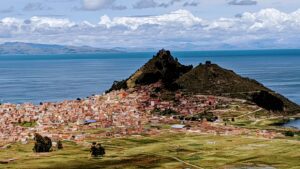
Before diving into prevention, let’s understand the foe. Altitude sickness, also known as Acute Mountain Sickness (AMS), occurs when your body struggles to adapt to the decreasing oxygen levels at higher altitudes. La Paz, Bolivia’s captivating capital, sits at a staggering 3,640 meters (11,942 ft), while the iconic Death Road reaches even higher elevations.
And don’t let Lake Titicaca’s beauty fool you. It is the world’s highest navigable lake at 3,810 meters (12,500 ft). Given this high altitude, and without proper acclimatization, it can definitely trigger AMS symptoms aka Bolivia altitude sickness.
Acclimatization is Key to Avoid Altitude Sickness in Bolivia

The golden rule? Ascend gradually to allow your body to adjust to the thinner air. Therefore, coming from sea level (we came from the Galapagos) directly into La Paz (the highest capital in the world) was not a very good idea. I knew I was in trouble the second we walked off the plane. The airport serving the capital sits at 4,084 meters (13,400 ft -even higher than La Paz itself). Immediately my head started to pound and every step was painful – the classic Bolivia altitude sickness.
So, what is the best way to avoid altitude sickness in Bolivia? Here’s the best Bolivia itinerary to prevent altitude sickness tips:
Start Low: Sucre, Bolivia’s charming colonial city at 2,810 meters (9,219 ft), provides the perfect base for acclimatization. Spend a few days exploring its historical gems while your body gets used to the altitude. This elevation is similar to the Sacred Valley and Cusco in Peru. Therefore, another option is to start there before heading to higher altitudes in Bolivia.
Climb Slowly: Avoid exceeding 300-400 meters (984-1,312 ft) of ascent per day, especially above 2,500 meters (8,202 ft). Consider taking rest days in stunning towns like Copacabana on the shores of Lake Titicaca to avoid altitude sickness in Bolivia.
Listen to Your Body: Feeling a headache, nausea, dizziness, or fatigue? These are early signs of AMS. Take it easy, rest, and descend if necessary. Don’t push your limits!
Altitude Sickness Aids – Prevent Altitude Sickness in Bolivia
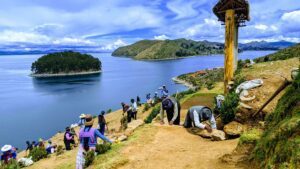
While acclimatization is crucial, here are some additional aids in your fight to prevent altitude sickness in Bolivia:
- Hydration: Drink plenty of water (2-4 liters daily) to combat dehydration, which worsens AMS symptoms. Avoid alcohol and excessive caffeine, as they can lead to dehydration.
- Coca Leaves: A long-standing tradition in the Andes, chewing coca leaves or drinking coca tea can help alleviate mild AMS symptoms.
- Altitude Medication: Consult your doctor about medications like Diamox, which can help prevent or lessen AMS symptoms.
- Nutrition: Fuel your body for high altitudes with potassium-rich foods (bananas, avocados, tomatoes) and complex carbs (whole grains, vegetables) for sustained energy. Skip salty options that worsen dehydration. Remember, healthy eating helps you adapt and thrive!
When we arrived in our Airbnb in La Paz we discovered that our apartment was situated on the 4th floor of a building with no elevator. At this point, I was already suffering from, altitude sickness. Rob thought that some food would be a good idea, so we ventured out to the only vegan restaurant we could find in the city.
Unfortunately, I did not get to keep that food for long, as I walked up and down the San Francisco-like streets of La Paz, with many hungry dogs following us. I spent the next 2 days in our apartment. Rob could not get up for 3 days. Thankfully our water purification system saved us. Had we not had that system, I may not be writing this blog today. The nearest store was many blocks away and we had no ability to walk anywhere further than the bed and the bathroom.
Best Bolivia Itinerary to Prevent Altitude Sickness
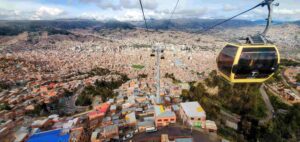
Here’s a possible itinerary to conquer Bolivia’s breathtaking landscapes while prioritizing acclimatization:
- Days 1-3: Explore Sucre’s charm, acclimatizing at 2,810 meters (9,219 ft). Consider a day trip to Tarabuco (for the Sunday market) it is situated at 3,050 meters (10,006 ft) and provides a gentle altitude increase.
- Day 4-5: Travel to Salar de Uyuni (Salt Flats), amid the Andes in southwest Bolivia. It is the world’s largest salt flat located at 3,663 m (12,018 ft).
- Days 6-8: Enjoy La Paz’s vibrant energy (3,640 meters/11,942 ft), mindful of your well-being. Riding the cable cars through all the neighborhoods is a must. Side trips include: Tiwanaku Ruins and Valle de la Luna
- Day 9: Embark on the Death Road Mountain Biking adventure. The 70 km (43 mile) descent begins at an altitude of 4,700 meters (15,400 ft) at La Cumbre, a windswept location on the way to the Yungas valleys. (see about our experience below).
- Day 10-12: Immerse yourself in the beauty of Copacabana on Lake Titicaca (3,810 meters/12,500 ft).
Remember: This is just a suggestion. Tailor your itinerary based on your fitness level, acclimatization needs, and desired experiences.
Death Road: No High Altitude Sickness Bolivia
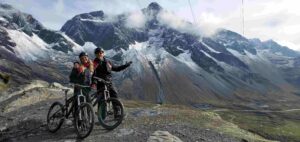
One of our favorite things to experience in Bolivia was mountain biking the Most Dangerous Road in the world (otherwise known as Yungas Road). While the thrill of cycling this legendary route is undeniable, remember, safety and acclimatization come first. We cycled this route with the most established organization called Gravity, Bolivia.
There are a lot of other outfitters here, however, Gravity has the best bikes and has a good safety record. Don’t expect a full suspension Santa Cruz. However, you will get an older hard tail with operating breaks (kind of important on a 5 hour descent). Along the way we met up with a few groups who opted for the cheaper operators and they were complaining about their breaks and the quality of their bikes non stop.
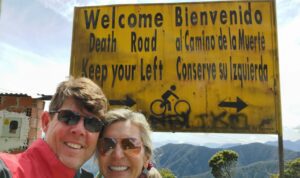
The company picked us up from our Airbnb in La Paz and drove us the 1.5 hours up, even higher into the mountains of Bolivia. We started at a dizzying elevation of 4,700 ft (15,400 ft) and descended for 5 hours (including a boxed lunch) through the valleys and mountains of gorgeous Bolivia.
Currently this road is only used for hiking and mountain biking, making this adventure far safer than the days when trucks and other vehicles competed for the narrow road and careened around it’s many bends and drops.
At first we found ourselves in deep clouds and mountain tops. However, after an hour or so the air cleared, it got slightly warmer and we were able to more clearly see, the verdant jungle, waterfalls and valleys below us. The views were spectacular. However, had we not properly acclimatized first, this bike ride would have been miserable if not impossible to do! It was certainly a highlight for us!
Wrap Up – How to Avoid Altitude Sickness in Bolivia
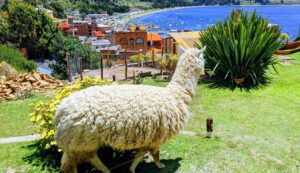
Bolivia is one of those countries filled with extraordinary vistas and adventures. It is a treasure trove of landscapes filled with soaring peaks, gorgeous valleys, verdant rain-forests and gigantic salt flats. Everything is the tallest and biggest here.
This country’s beauty is stunning and diverse, offering something for every traveler. Towering peaks pierce the skies, while Lake Titicaca, the world’s highest navigable lake, stretches out in a vast deep blue expanse. The Salar de Uyuni, the world’s largest salt flat, creates a surreal landscape with its endless white plains mirroring the sky.
Lush rain-forests like Madidi National Park burst with diverse wildlife, and the Amazon Basin offers a glimpse into untouched biodiversity. Beyond its natural wonders, Bolivia is rich in culture, with indigenous communities preserving traditions and vibrant textiles woven into daily life. From the colonial charm of Sucre to the bustling energy of La Paz, Bolivia offers a captivating blend of nature, culture, and history, waiting to be explored.
However, none of these experiences are pleasant if we aren’t prepared to prevent altitude sickness in Bolivia. We have reviewed different ways of how to avoid altitude sickness in Bolivia:
- Start at a lower altitude like Sucre to acclimatize
- Increase altitude slowly – no more than 300-400 meters per day
- Listen to your body – if you start to feel the symptoms of altitude sickness descend to a lower altitude or take a rest day or two
- Hydrate by drinking 2-4 litres of water per day, avoid caffeine and alcohol
- Chew cocoa leaves or drink cocoa tea throughout the first week or so while at altitude
- Take altitude sickness medication like Diamox
- Fuel your body with potassium rich foods and avoid salt
- Follow an itinerary that starts at a lower altitude and builds slowly (see above, best Bolivia itinerary)
We hope that these tips of how to avoid altitude sickness in Bolivia help you to ease into this gorgeous country and truly enjoy it’s beauty without suffering the dreaded Bolivia altitude sickness.
Have you been to Bolivia or other high altitude countries? Do you have other tips to prevent altitude sickness in Bolivia or other countries with high altitudes? We would love to hear from you in the comments!

